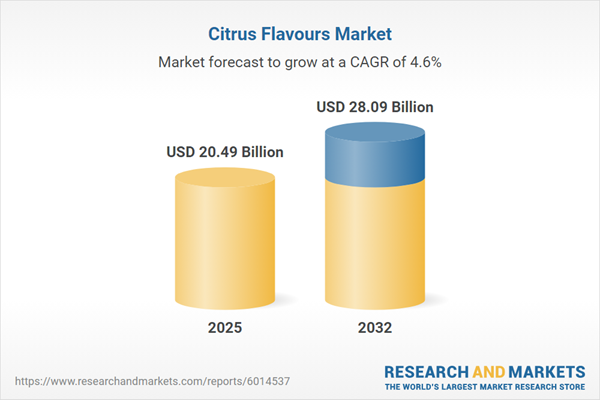Speak directly to the analyst to clarify any post sales queries you may have.
The citrus flavours market is undergoing significant transformation, driven by evolving consumer demands, advancing regulations, and heightened sustainability expectations. Senior decision-makers need comprehensive, actionable market intelligence to effectively navigate sourcing, processing, and supply challenges in this dynamic sector.
Citrus Flavours Market Snapshot: Growth and Trends
In 2024, the global citrus flavours market is valued at USD 19.58 billion, with a projected increase to USD 20.49 billion by 2025 and USD 28.09 billion by 2032. The compound annual growth rate stands at 4.61%. This growth is underpinned by increasing demand for natural and clean-label ingredients, as health and product integrity stand at the forefront of consumer preferences. Industry leaders are prioritizing investments in process modernization and transparency, as well as tailoring supply chain approaches to meet local and regulatory demands. Regional innovation, spanning North America, Europe, and Asia-Pacific, is enabling companies to address varied application needs and maintain diverse product portfolios in the competitively evolving citrus flavours market.
Citrus Flavours Market: Scope & Segmentation
- Product Form: Essential oils obtained from cold pressing, solvent extraction, steam distillation, and supercritical CO2 extraction are utilized across food, beverage, and industrial markets. Alcohol- and CO2-based extracts yield high purity blends, while juice concentrates—available as frozen or dehydrated formats—provide adaptable formulation options. Zest powders, created via drum or spray drying, contribute to faster product development and scalable manufacturing.
- Citrus Type: Grapefruit, lemon, lime, orange, and tangerine varieties enable adaptable product creation and support regionally targeted or sector-specific applications, expanding commercial reach.
- Extraction Method: Techniques such as cold pressing, solvent extraction, steam distillation, and supercritical CO2 are adapted to deliver desired flavour profiles and remain in compliance with evolving regulatory standards.
- Application: Citrus flavours are implemented within cleaning products, cosmetics, pharmaceuticals, bakery items, dairy, confectionery, desserts, and soft drinks, enabling companies to operate across both mass-market and premium segments.
- Distribution Channel: The market utilizes HORECA, industrial procurement, online, and retail channels, meeting both high-volume and niche supply requirements on a global scale.
- Geography: Sourcing and manufacturing strategies are shaped by regional regulatory frameworks and consumer trends in the Americas, Europe, Middle East and Africa, and Asia-Pacific, impacting supply chain agility and product development.
- Leading Companies: Givaudan SA, International Flavors & Fragrances Inc., Firmenich SA, Symrise AG, Takasago International Corporation, Kerry Group plc, Sensient Technologies Corporation, Döhler GmbH, MANE & CIE, and Robertet Group focus on regulatory alignment, technological advancement, and sustainability throughout the value chain.
Citrus Flavours Market: Key Takeaways for Decision-Makers
- Integrating low-energy extraction processes and closed-loop solvent recovery helps manufacturers reduce operational costs while advancing sustainability objectives throughout production.
- Deploying batch-level traceability solutions elevates transparency across supply chains, building customer trust and supporting a clean-label product strategy.
- Advanced techniques like supercritical CO2 extraction, paired with data analytics, unlock new applications in sectors such as nutraceuticals and cosmetics.
- Agile supply models—ensuring raw material continuity in the Americas, regulatory compliance in Europe and the Middle East, and process adaptation in Asia-Pacific—allow rapid response to market changes.
- Collaborating closely with growers and technology partners enhances sourcing resilience, streamlines quality standards, and promotes the adoption of disease-resistant citrus breeds to counter volatility in raw material supply.
Tariff Impact: Navigating Regulatory Shifts in 2025
With pending changes to US tariffs on citrus imports, organizations must review procurement strategies. Senior leaders should focus on renegotiating supplier agreements, considering domestic sourcing alternatives, and reinforcing financial controls to anticipate and manage risks associated with evolving trade regulations.
Methodology & Data Sources
This analysis is grounded in in-depth interviews with industry executives and operational practitioners. Supplementing these primary sources, the report incorporates insights from peer-reviewed research, regulatory documentation, and industry workshops to equip decision-makers with credible and actionable intelligence.
Why This Report Matters
- Delivers strategy-driven guidance for harnessing new market opportunities and realigning distribution models in response to shifting regulatory and consumer demands.
- Clarifies complex sourcing and operational considerations, empowering leadership to build processes that are both sustainable and compliant.
- Provides a nuanced view of evolving technologies and market shifts, supporting robust, data-informed decisions and long-term organizational adaptability.
Conclusion
This report furnishes senior leadership with concise, actionable guidance for strategic decision-making in the citrus flavours industry. Organizations can leverage these insights to strengthen operations, reinforce supply chains, and adapt to ongoing shifts in the global market environment.
Additional Product Information:
- Purchase of this report includes 1 year online access with quarterly updates.
- This report can be updated on request. Please contact our Customer Experience team using the Ask a Question widget on our website.
Table of Contents
3. Executive Summary
4. Market Overview
7. Cumulative Impact of Artificial Intelligence 2025
Companies Mentioned
The companies profiled in this Citrus Flavours market report include:- Givaudan SA
- International Flavors & Fragrances Inc.
- Firmenich SA
- Symrise AG
- Takasago International Corporation
- Kerry Group plc
- Sensient Technologies Corporation
- Döhler GmbH
- MANE & CIE
- Robertet Group
Table Information
| Report Attribute | Details |
|---|---|
| No. of Pages | 188 |
| Published | October 2025 |
| Forecast Period | 2025 - 2032 |
| Estimated Market Value ( USD | $ 20.49 Billion |
| Forecasted Market Value ( USD | $ 28.09 Billion |
| Compound Annual Growth Rate | 4.6% |
| Regions Covered | Global |
| No. of Companies Mentioned | 11 |









